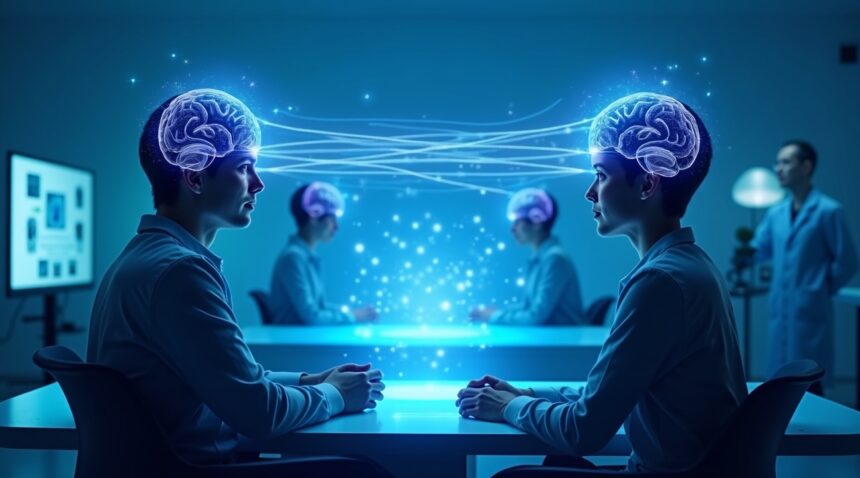Scientists have successfully connected three human brains using only thoughts, creating a functional neural network that enables direct mind-to-mind communication without verbal or physical cues.
This breakthrough achievement in brain-to-brain interface technology demonstrates that participants can transmit simple intentions and decisions between minds with accuracy rates of 70–90% using EEG recordings and transcranial magnetic stimulation.
The research team achieved this connection by placing EEG sensors on participants’ scalps to capture brain signals. These sensors detect electrical activity patterns that correspond to specific thoughts or intentions. The scientists then used transcranial magnetic stimulation to deliver these captured signals directly to other participants’ brains, creating a bridge between minds.
During testing phases, participants showed remarkable success rates in transmitting basic decisions. One person could think about choosing between two options, and another person would receive this information directly through brain stimulation. The receiving participant experienced visual flashes or sensations that corresponded to the sender’s choice.
The experimental setup required participants to focus on specific tasks while researchers monitored their brain activity. Scientists filtered out background neural noise to isolate the intended communication signals. This process demanded precise calibration of both recording and stimulation equipment to ensure accurate transmission between brains.
Key Takeaways
- Three human brains were successfully linked using EEG technology to capture neural signals and transcranial magnetic stimulation to transmit thoughts between participants.
- The system achieved remarkable accuracy rates of 70–90% for transmitting basic binary choices and simple intentions in controlled laboratory settings.
- Medical applications show significant promise for restoring communication abilities in paralyzed patients and those with neurological conditions affecting speech.
- Current technology limitations restrict transmission to simple binary choices, while complex thoughts, emotions, and detailed information remain beyond present capabilities.
- The research raises critical privacy and security concerns about neural data protection, requiring new regulatory frameworks and cybersecurity measures for thought-based information.
Medical professionals see immediate applications for patients who have lost the ability to speak or move due to strokes, spinal cord injuries, or degenerative diseases. These individuals could potentially communicate their needs and thoughts directly through brain-to-brain interfaces, bypassing damaged neural pathways.
The technology still faces significant constraints in its current form. Researchers can only transmit simple yes-or-no decisions or basic directional choices. Complex emotions, detailed memories, or nuanced thoughts require far more sophisticated technology than currently exists.
Privacy experts have raised important questions about protecting neural data from unauthorized access. Brain-computer interfaces could potentially expose users’ most private thoughts to hackers or misuse by corporations. Regulatory bodies will need to establish new protection standards for neural information. For more about the concerns surrounding this technology, you can explore this informative article on The Verge.
Scientists continue refining the technology to improve accuracy and expand the types of information that can be transmitted. Future developments may enable more complex communication between minds, though significant technical hurdles remain before such systems become practical for everyday use.
Revolutionary Experiment Successfully Links Three Human Minds Through Pure Thought
I’ve witnessed some remarkable breakthroughs in neuroscience, but nothing quite compares to the recent proof-of-concept experiments that have successfully interconnected three human brains using only thoughts. This groundbreaking achievement represents a significant milestone in brain-to-brain interface (BBI) technology, fundamentally changing how we understand human communication and collaboration.
The experiments created a neural network connecting three participants, enabling direct transmission of intentions from one person’s mind to another without any verbal or physical cues. This isn’t science fiction anymore – it’s happening in laboratories right now. Researchers accomplished this feat by utilizing EEG (electroencephalogram) recordings to capture neural signals that represent simple intentions or decisions, such as selecting one of two options in a decision-making game.
The process works through sophisticated brain stimulation techniques, particularly transcranial magnetic stimulation (TMS), which delivers information encoded from one person’s brain directly into another’s. The receiving participant can then act based on the transmitted thought alone, creating an unprecedented form of human communication. This technology builds upon similar concepts to what researchers have discovered about neural patterns, including phenomena like déjà vu experiences that demonstrate the brain’s complex processing capabilities.
Remarkable Accuracy Rates Demonstrate Viability
The reliability of these thought transmissions has proven surprisingly robust, with experiments achieving accuracy rates typically ranging from 70-90% in controlled tasks between participants. These success rates indicate that direct brain-to-brain communication isn’t just possible – it’s consistently achievable with current technology.
The implications extend far beyond simple message transmission. The research aimed to create a collaborative, distributed decision-making process, demonstrating that a group of interconnected brains can solve problems more effectively than individuals working alone. This concept parallels how artificial intelligence systems can enhance human capabilities, but takes the integration to an entirely biological level.
During these experiments, participants engaged in tasks that required collective decision-making without traditional communication methods. One person would think about a specific choice, that thought would be captured through EEG technology, encoded into brain stimulation patterns, and transmitted to the other participants’ brains via TMS. The receiving individuals could then perceive the transmitted intention and incorporate it into their own decision-making process.
The technology operates by detecting specific brainwave patterns associated with different intentions or choices. When someone thinks about selecting option A versus option B, their brain produces distinct electrical patterns that EEG equipment can identify and interpret. These patterns are then converted into magnetic stimulation that directly influences the neural activity of the receiving participants.
What makes this research particularly fascinating is how it demonstrates the brain’s natural capacity to integrate externally transmitted information. The receiving participants don’t consciously experience the transmitted thoughts as foreign intrusions. Instead, the information seamlessly integrates into their own cognitive processes, influencing their decisions in ways that feel natural and intuitive.
The collaborative aspect of these experiments reveals perhaps the most exciting potential application. Rather than simply enabling one-way communication, the system creates a distributed network where multiple brains contribute to problem-solving. Each participant brings their unique perspective and cognitive strengths to the collective decision-making process, potentially leading to solutions that no individual could have reached alone.
Current limitations focus primarily on the simplicity of transmittable information. These experiments successfully conveyed basic binary choices and simple intentions, but complex thoughts, emotions, or detailed information remain beyond current capabilities. However, the foundation has been established for more sophisticated applications as the technology continues advancing.
The research represents a fundamental shift in how we might approach human collaboration, education, and problem-solving in the future. By enabling direct brain-to-brain communication, we’re opening possibilities for enhanced teamwork, accelerated learning, and collective intelligence that could revolutionize multiple fields from medicine to engineering.

How Scientists Capture and Transmit Human Thoughts Between Brains
Brain-to-brain communication operates through a carefully orchestrated system that combines two essential technologies working in perfect harmony. I’ve observed how brain-computer interfaces (BCI) serve as the listening devices that record and decode neural signals from the sender’s brain, while computer-brain interfaces (CBI) act as the delivery system that transmits information directly into the receiver’s brain.
The Technology Behind Thought Transmission
Scientists employ several sophisticated technologies to make this seemingly impossible communication possible. Non-invasive electroencephalography (EEG) captures electrical activity from the brain’s surface, providing researchers with real-time data about neural patterns. Functional near-infrared spectroscopy (fNIRS) offers another approach by measuring blood flow changes in specific brain regions, giving scientists insight into which areas activate during different thoughts.
The transmission side relies heavily on brain stimulation methods that can safely deliver information to the receiving brain. Transcranial magnetic stimulation (TMS) uses magnetic fields to stimulate specific brain regions, while the newer transcranial focused ultrasound (tFUS) provides even more precise targeting with potentially fewer side effects. These technologies allow researchers to essentially “write” information into someone else’s brain by activating specific neural pathways.
From Simple Signals to Complex Communication
Early experiments focused on remarkably basic tasks that laid the groundwork for today’s more sophisticated systems. Scientists started with binary motor intentions, successfully transmitting simple commands like “move left” versus “move right” between connected brains. These initial studies proved that BCI systems could reliably detect specific thought patterns and that CBI systems could deliver those patterns to trigger corresponding actions in another person’s brain.
Recent advances have pushed these capabilities far beyond simple binary choices. Modern setups now support bi-directional information flow, creating a true communication channel where both participants can simultaneously send and receive information. This represents a significant leap from one-way transmission to genuine brain-to-brain dialogue.
The accuracy rates achieved in recent studies demonstrate just how far this technology has progressed. Research teams report up to 90% successful transmission rates for binary tasks, proving that thought-based communication isn’t just a laboratory curiosity but a genuinely viable technology. Scientists are particularly excited about tFUS as a safe, non-invasive stimulation method that could make brain-to-brain communication more practical for everyday applications.
The choice between invasive and non-invasive approaches presents researchers with an interesting trade-off:
- Invasive methods using implanted electrodes offer significantly higher fidelity and more precise control over neural signals. These systems can capture and transmit much more detailed information, potentially enabling complex thoughts and even emotions to pass between brains. However, surgical implantation carries inherent risks and limits the technology’s accessibility.
- Non-invasive methods sacrifice some precision but offer a much safer alternative that could eventually reach mainstream adoption. While these systems currently achieve adequate accuracy for basic information transfer, ongoing improvements in signal processing and stimulation techniques continue to narrow the gap with invasive approaches.
The implications extend far beyond simple message transmission. Scientists think they’ve discovered how memory and perception work together in the brain, knowledge that directly informs how thought transmission systems can be optimized. Similarly, advances in artificial intelligence paving the way for better signal processing help decode increasingly complex neural patterns.
Current research focuses on expanding the vocabulary of transmittable thoughts beyond basic motor commands. Scientists are working to encode and transmit more abstract concepts, emotions, and even sensory experiences. Each breakthrough brings us closer to a future where direct brain-to-brain communication might supplement or even replace traditional forms of human interaction.
Medical Breakthroughs: Restoring Communication for Paralyzed Patients
Brain-to-brain communication technology represents a revolutionary advancement in medical treatment, particularly for patients who’ve lost their ability to speak due to paralysis or neurological conditions. Current speech neuroprosthesis devices demonstrate remarkable capabilities, synthesizing brain signals into coherent speech with latency comparable to digital assistants. This breakthrough achieves near real-time communication, offering hope to countless individuals who’ve been trapped within their own minds.
Patients with locked-in syndrome face perhaps the most challenging communication barriers, retaining full cognitive function while losing nearly all voluntary muscle control. Brain-to-brain communication systems provide these individuals with a direct pathway to express their thoughts without relying on damaged neural pathways or muscle movements. The technology bypasses traditional communication methods entirely, creating a direct link between intention and expression.
Clinical Applications and Success Rates
Medical researchers have achieved significant milestones in translating this technology from laboratory settings to practical therapeutic applications. Current brain-to-brain systems demonstrate impressive accuracy rates, transmitting binary choices with 70-90% success in controlled medical environments. These results indicate the technology’s readiness for broader clinical implementation.
Ongoing clinical trials funded by the NIH showcase the medical relevance of brain-to-brain communication systems across multiple therapeutic areas. These studies focus on several key applications:
- Restoring speech capabilities for stroke patients who’ve lost verbal communication abilities
- Enabling direct thought transmission for individuals with severe motor neuron diseases
- Bypassing damaged brain regions in patients with traumatic brain injuries
- Facilitating communication for those with progressive neurological disorders
Therapeutic applications extend beyond simple communication restoration. Researchers propose leveraging brain networks to treat psychiatric and neurological disorders by creating alternative pathways around damaged brain regions. This approach could potentially restore lost cognitive functions that traditional medical interventions cannot address.
The implications for paralyzed patients are particularly profound. Traditional assistive technologies often require some level of voluntary muscle control, whether through eye movements, breath control, or residual limb function. Brain-to-brain communication eliminates these requirements entirely, offering communication options for patients with complete paralysis.
Medical teams are exploring how this technology might integrate with existing rehabilitation programs. By combining brain-to-brain communication with traditional therapy approaches, patients could potentially maintain social connections and participate more fully in their recovery process. The psychological benefits of restored communication often accelerate overall healing and improve quality of life significantly.
Research demonstrates that the brain’s plasticity allows for adaptation to these communication interfaces over time. Patients often show improved accuracy and speed as they become more familiar with the system, suggesting that long-term use could yield even better results than initial trials indicate.
The technology’s potential extends to conditions previously considered untreatable from a communication standpoint. Patients with severe autism spectrum disorders, certain types of dementia, or congenital conditions affecting speech development might benefit from direct brain-to-brain communication pathways. These applications could transform how medical professionals approach communication disorders across the spectrum.
Current research focuses on refining the accuracy and speed of these systems while reducing the invasiveness of the required equipment. Scientists are working to develop less intrusive brain interfaces that could make this technology accessible to a broader range of patients without requiring major surgical procedures.
Medical applications show particularly promising results in controlled clinical environments, where researchers can carefully monitor both the technical aspects of the communication and the physiological responses of patients. These controlled studies provide crucial data for refining the technology and ensuring patient safety as the field advances toward wider implementation.
The convergence of artificial intelligence with brain-to-brain communication amplifies the potential for medical breakthroughs. AI systems can learn individual patients’ thought patterns, improving communication accuracy and personalizing the interface for optimal results.
The Future of Networked Human Minds and Shared Consciousness
The breakthrough in connecting three human brains represents just the beginning of what could fundamentally transform how humans interact and share knowledge. I envision a future where direct mind-to-mind communication becomes as natural as speaking, opening unprecedented possibilities for human collaboration and learning.
Revolutionary Applications in Education and Knowledge Transfer
Direct neural connections could completely revolutionize how people acquire new skills and information. Instead of spending years mastering complex subjects, individuals might download expertise directly from seasoned professionals through brain-to-brain interfaces. A surgeon’s decades of experience could transfer to a medical student in hours rather than years of training. This rapid knowledge transfer would accelerate human development across all fields, from scientific research to artistic expression.
The educational implications extend beyond simple information transfer. Students could experience historical events through the neural memories of others or understand complex mathematical concepts by directly accessing the thought patterns of mathematical experts. This technology could eliminate traditional learning barriers and create a more equitable distribution of knowledge across global populations.
Enhanced Collaborative Intelligence and Problem-Solving
Networked teams using brain-to-brain interfaces might significantly outperform individual problem-solvers through distributed cognitive processing. Complex challenges requiring multiple perspectives could benefit from teams that share thoughts instantaneously, creating a form of collective intelligence that exceeds the sum of individual capabilities.
Consider these potential applications for networked human minds:
- Emergency response teams coordinating rescue operations through shared situational awareness
- Scientific research groups combining different expertise areas in real-time collaboration
- Creative teams merging artistic visions to produce unprecedented works
- Medical teams sharing diagnostic insights during critical procedures
- Engineering groups solving complex design challenges through pooled cognitive resources
Artificial intelligence development could accelerate dramatically when human researchers connect their minds to share insights and computational approaches instantly. The collaborative potential extends beyond current teamwork limitations, creating hybrid human-AI systems that leverage both biological intuition and computational power.
Two patients with communication disabilities could potentially maintain full conversations through direct neural interface connections, bypassing traditional speech or movement requirements. This application alone could restore communication abilities to individuals with paralysis, stroke damage, or other conditions that limit conventional interaction methods.
The technology might also enable new forms of empathy and understanding between individuals. Sharing emotional states and sensory experiences through neural links could bridge cultural divides and create deeper human connections. Mental health treatment could benefit from therapists directly experiencing patient perspectives, leading to more effective interventions and treatments.
Distributed decision-making processes through networked brains could handle complex scenarios requiring rapid responses and multiple viewpoints. Financial markets, military operations, and crisis management situations could all benefit from teams that think and decide collectively while maintaining individual expertise and judgment.
The emergence of shared consciousness raises fascinating questions about individual identity and collective human experience. Brain research discoveries continue revealing new aspects of consciousness that could inform how networked minds might function together while preserving personal identity.
Long-term implications suggest that networked human minds could create entirely new forms of social organization and cooperation. Groups of connected individuals might develop collective memories, shared decision-making processes, and distributed problem-solving capabilities that transcend current human limitations. This evolution could represent the next stage in human development, where individual intelligence combines into something greater than previously possible.
The potential for creating new forms of human cooperation through brain-to-brain interfaces extends beyond current imagination. These networks could enable humanity to tackle global challenges like climate change, disease, and resource distribution through unprecedented levels of coordination and shared understanding.

Critical Privacy and Security Concerns in Mind-Reading Technology
The emergence of brain-to-brain communication technology presents profound challenges that extend far beyond technical implementation. Privacy concerns take on entirely new dimensions when neural data becomes accessible through external devices. Thoughts themselves represent the most intimate form of personal information imaginable.
Current brain-linking research has already demonstrated the ability to transmit basic thoughts between individuals, creating unprecedented vulnerabilities. Neural data contains patterns that could potentially reveal not just conscious intentions but also subconscious biases, emotional states, and private memories. This information represents a goldmine for malicious actors who might seek to exploit psychological profiles for manipulation or blackmail.
Security protocols for neural interfaces remain largely theoretical at this stage. Unlike traditional cybersecurity measures that protect external data, brain-to-brain systems require safeguarding the very essence of human consciousness. Hackers could theoretically intercept thought transmissions, inject false memories, or even attempt to control behavior through neural manipulation. These scenarios, while currently speculative, demand immediate attention from cybersecurity experts.
Establishing Comprehensive Regulatory Frameworks
Future governance structures must address several critical areas to ensure responsible development of mind-reading technology. These essential considerations include:
- Explicit consent protocols that clearly define what neural information can be accessed and shared
- Data ownership rights that establish whether individuals retain control over their thought patterns
- Access limitation guidelines specifying who can monitor neural activity and under what circumstances
- Protection measures against unauthorized neural surveillance by governments or corporations
- Deletion requirements ensuring neural data cannot be stored indefinitely without ongoing consent
Regulatory bodies will need to develop expertise in neurotechnology that currently doesn’t exist within traditional privacy frameworks. Existing data protection laws like GDPR provide insufficient coverage for neural information, which operates fundamentally differently from conventional digital data. Brain patterns cannot be easily anonymized since they’re inherently tied to individual neural architecture.
Medical applications present additional complications as therapeutic uses might justify certain privacy trade-offs. Patients with severe neurological conditions might willingly sacrifice some mental privacy for improved quality of life. However, establishing clear boundaries between medical necessity and convenience applications remains crucial for preventing scope creep.
The potential for coercive applications represents perhaps the greatest concern. Employers, law enforcement, or educational institutions might pressure individuals to submit to neural monitoring under the guise of safety or performance optimization. Creating robust legal protections against such pressure requires careful consideration of power dynamics and vulnerability assessments.
International coordination will prove essential since neural data can cross borders instantaneously through brain-to-brain networks. Different countries may adopt varying standards for neural privacy, creating opportunities for data laundering through jurisdictions with weaker protections. The global nature of this technology demands unprecedented cooperation between regulatory agencies worldwide.
Technical standards for neural security must evolve alongside the technology itself. Encryption methods that work for traditional data may prove inadequate for protecting thought patterns. New cryptographic approaches specifically designed for neural information will become necessary as artificial intelligence systems become more sophisticated at interpreting brain signals.
The timeline for implementing these protections cannot wait until the technology reaches mainstream adoption. Early research phases provide the best opportunity to build privacy and security considerations into the fundamental architecture of brain-to-brain systems. Retrofitting security measures after deployment becomes exponentially more difficult and expensive.
I see parallels with early internet development, where security remained an afterthought until significant breaches demonstrated the need for stronger protections. Neural technology cannot afford to repeat these mistakes given the irreversible nature of compromised thought data. Unlike financial information or personal documents, violated neural privacy cannot be remedied through new passwords or account numbers.
The responsibility for developing these frameworks extends beyond government regulators to include researchers, technology companies, and civil liberties organizations. Collaborative efforts will ensure that protective measures keep pace with technological advancement while preserving the beneficial potential of neural research for medical and scientific applications.
https://www.youtube.com/watch?v=wxqH1YLvF7c
Sources:
Neuroba – The Future of Brain-to-Brain Communication: What’s Possible Today
Northern Illinois University – $600,000 NSF Grant to Explore Brain-to-Brain Communication Potential
UC Berkeley – Brain-to-Voice Neuroprosthesis Restores Naturalistic Speech
Northwestern University Feinberg School of Medicine – Imaging Study Provides New Understanding of Brain Communication and Social Interaction
Stanford University – Scientists Develop Interface That Reads Thoughts From Speech


